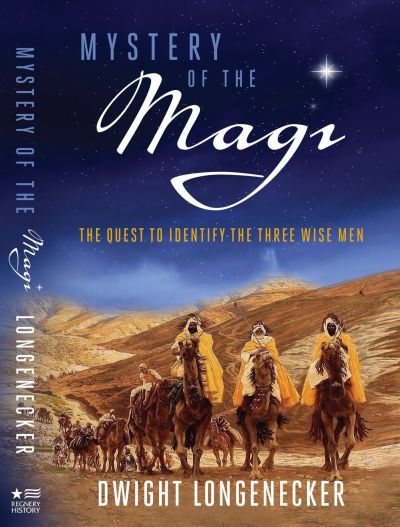Mystery of the Magi: The Quest to Identify the Three Wise Men

God in human form. Every year the mystical Magi of Shir ascend their holy mountain to the Cave of Treasures, which contains the wisdom of Seth and the treasures of Adam. Here a star brighter than the sun appears to them as a tiny, radiant human, telling them to go on a long journey to Bethlehem. Setting off, they find that the star child accompanies them, removing all obstacles and miraculously providing them with food and protection.
When they arrive at Bethlehem, Mary accuses them of wanting to steal the child, but they inform her that he is the savior of the world. When they return to the land of Shir, they tell their people what has happened, and all rejoice. Many years later, the apostle Thomas appears and baptizes them, and they all live happily ever after.
Myth or Mistake?
While these fairy tales about the wise men are interesting, they expose the very worst tendencies of Gnostic Christianity, which was enchanted by fanciful myths, bogus mysticism, and arcane knowledge.
Gnosticism, which would flourish in various forms during the first five centuries of the Christian era, was already a force during the time of the Apostles. Paul, for example, warned the Colossians not to be taken in by empty philosophies, fanciful stories, and secret knowl- edge about "the elemental spirits."11 And he adjured his young disciple Timothy, "Turn away from godless chatter and the opposing ideas of what is falsely called knowledge, which some have professed and in so doing have departed from the faith."12 The epistles of John castigate false teachers who "deny that Jesus Christ is come in the flesh"13—in other words, those who deny that factual history matters when it comes to the story of Jesus of Nazareth.
Paul and John insist that the events of Jesus' life, death, and resur- rection are not fanciful fictions but historical fact, in which all sound doctrine must be rooted. To the Corinthians, for example, Paul writes, "If Christ is not raised from the dead your faith is futile,"14 and "I
delivered to you as of first importance what I also received: that Christ died for our sins in accordance with the scriptures, that he was buried, that he was raised on the third day in accordance with the scriptures, and that he appeared to Cephas [Peter], then to the twelve."15
Christianity is rooted in the facts of history, not in fanciful fic- tion, superstition, secret knowledge, and bizarre cosmic theories. While the Protoevangelium rather innocently embellished the original story, tales like The Revelation of the Magi and "The Legend of Aphroditianus" are complete fabrications from beginning to end. These Gnostic texts have no value apart from being mildly entertain- ing historical curiosities. They are as important to the search for Matthew's wise men as Disney's Sword in the Stone is to the search for King Arthur.
The Medieval Myth
By the sixth century, Christians may not have fallen for the wildly fantastic stories of the Gnostics, but the idea that the Magi were wise men from Persia had taken root. So in the sixth century we find the Emperor Justinian commissioning the famous mosaic of the three Magi in Ravenna, their pointed Phrygian caps and pantaloons indicating their Persian origins. Similar iconography from the same period is found in Rome at the Church of Santa Sabina and in the catacombs.
The earliest known source for the wise men's names is a late- fifth-century chronicle, composed in Greek in Alexandria and known today only in a (very poor) eighth-century Latin translation, which identifies them as "Bithisarea," "Melichior," and "Gath- aspa"—or, as we know them, Balthasar, Melchior, and Caspar, the names with which the figures in Justinian's mosaic are labeled.16
Two centuries earlier, a Syrian writer had named them Hormizdah, king of Persia; Yazdegerd, king of Saba; and Perozadh, king of Sheba.17 Syriac Christians had named the Magi Larvandad, Gush- nasaph, and Hormisdas.18 Ethiopians called them Hor, Karsudan,
and Basanater,19 while the Armenians said they were named, Kag- pha, Badadakharida, and Badadilma.20
The various ethnic names of the Magi also indicate a broadening of the tradition from the assumption that they were Persian priests. The Syrians, Ethiopians, and Armenians were among the first peoples to accept the Christian message. Their independent Magi traditions attest to the antiquity of their faith and affirm Augustine of Hippo's suggestions that the wise men represented the whole of the Gentile (non-Jewish) world.21
Written some two hundred years after Justinian's famous mosaics, an eighth-century Irish manuscript offers more details about the appearance of the wise men, explaining that they represent the three ages of man (youth, middle age, and old age). By this time they were no longer Persian but had assumed racial characteristics indicating that one was European, one African, and one Asian—representing
the three regions of the known world.22 The Venerable Bede, writing in early-eighth-century Britain, mused that the international origins of the three wise men could also signify the three sons of Noah, who, as tradition had it, re-peopled the globe and were the source of humanity's three basic racial groups. He summarized the tale as it was known in his time:
The Magi were the ones who gave gifts to the Lord. The first is said to have been Melchior, an old man with white hair and a long beard . . . who offered gold to the Lord as to a king. The second, Gaspard by name, young and beardless and ruddy complexioned, . . . honored him as God by his gift of incense, an oblation worthy of divinity. The third, black skinned and heavily bearded, named Balthasar, . . . by his gift of myrrh testified to the Son of Man who was to die.23
The legends continued to develop, and according to the twelfth- century life of Saint Eustorgio, the bodies of the three kings were discovered in Persia in the early fourth century by Helena, the mother of the emperor Constantine. The relics were transferred to the great church of Hagia Sophia in Constantinople. When Eustorgio became bishop of Milan, he petitioned the emperor to enshrine the relics of the Magi in his city. In 1164, when Milan was looted by the army of Frederick Barbarossa, the bones of the three kings were removed to Cologne, Germany, where they remain, entombed in the great Gothic cathedral in a magnificent gold and enamel shrine.
In the fourteenth century the Venetian explorer Marco Polo recorded that he had visited the village in Persia where Helena had identified the tomb of the Magi. And in the same century, the Car- melite monk John of Hildesheim, in his History of the Three Kings, recounted how the star was first sighted in the forty-second year of the emperor Augustus from the summit of Mount Vaus in the East by a group of pagan astrologers who were aware of the Old Testament prophecy of Balaam.24
The star, writes John, was as bright as the sun. Melchior traveled from Nubia and Arabia, Balthasar from Godolia and Saba, and Cas- par from Tharsis and Egrisoulle. Each king, with a magnificent reti- nue, followed the star for thirteen days. Arriving in Jerusalem on the same day, they were amazed to discover that they could understand one another's languages. After their audience with King Herod, and instructed by his scribes, they continued their journey to Bethlehem, again guided by the magical star.
Like the story of Saint Nicholas, who became the modern Santa Claus, the story of the wise men grew into legend and expanded into myth. From Syria and North Africa to Europe and then around the world, Matthew's simple story not only grew but also influenced world culture.
The Modern Myth
The medieval version of the story—with an old man, a middle- aged man, and a youth, each of a different race—influenced virtually all Western Christian art from the late Middle Ages onward. The story of the kings has also influenced cultural understandings and movements within Christian Europe and around the world even to the present day.25
In the school Christmas pageant each December you will probably see the three kings portrayed by boys from three different races, just as the kings were portrayed in medieval mystery plays. One may wear a long beard, while another is middle-aged and the third youthful. They will follow a magical star and bear the names of Melchior, Caspar, and Balthasar. It will all be sweet and enchanting, but it owes more to the legends that developed about the Magi than the simple story that Matthew records.
With the rise of Islam in the early seventh century, both Zoroas- trianism and Christianity came under a cloud in the Middle East. It is no coincidence that this was the time that Christians stopped portray- ing the wise men as Persian Zoroastrian priests. By the eighth century, as we have seen, even in remote Ireland and Britain, the Magi had become kings from Europe, Asia, and Africa. As the wise men were universalized, they were untethered from their geographical and his- torical moorings. It was as if the Magi resided in the realm of mythical meaning, and if anyone asked who they really were and where they really came from, a learned professor would peer over his glasses and say, "It is likely that, if they truly existed, they were members of the ancient Persian caste of sorcerers and stargazers called magi."
Now in the twenty-first century, that is still the default setting. Most scholars do not think the question of the historical identity of the Magi is even worth asking about, and those who do enquire are usually content with the pat answer that they may have been Persian Zoroastrian priests.
But if they existed, did the Magi come from Persia?
The more one examines that answer, the more the riddle deepens.
Dwight Longenecker is a Catholic priest, award winning blogger, and freelance writer. A graduate of Oxford and Bob Jones University, he has written sixteen books on different aspects of religion. Longenecker is a highly sought-after speaker for scholarly and Men's Conference events, and often leads parish missions, retreats, and diocesan events. He and his wife, Allison, have four children. Longenecker serves as pastor of Our Lady of the Rosary Church in Greenville, South Carolina.



























